The Status of South Africa’s Freshwater Fish Fauna: A Spatial Analysis of Diversity, Threat, Invasion, and Protection
Abstract
:1. Introduction
2. Materials and Methods
2.1. Study Site
2.2. Data Collection and Cleaning
2.3. Data Analysis
3. Results
3.1. Spatial Distribution of Records
3.2. Species Richness
3.3. Protected Areas
4. Discussion
4.1. Spatial Distribution of Records
4.2. Species Richness
4.3. Protected Areas
4.4. Limitations
5. Conclusions
Supplementary Materials
Author Contributions
Funding
Institutional Review Board Statement
Data Availability Statement
Acknowledgments
Conflicts of Interest
References
- Darwall, W.; Smith, K.; Allen, D.; Seddon, M.; Reid, G.M.; Clausnitzer, V.; Kalkman, V.J. Freshwater Biodiversity: A Hidden Resource under Threat. In Wildlife in a Changing World–An Analysis of the 2008 IUCN Red List of Threatened Species; IUCN: Gland, Switzerland, 2009; Volume 43. [Google Scholar]
- Best, J. Anthropogenic Stresses on the World’s Big Rivers. Nat. Geosci. 2019, 12, 7–21. [Google Scholar] [CrossRef]
- Dudgeon, D.; Arthington, A.H.; Gessner, M.O.; Kawabata, Z.-I.; Knowler, D.J.; Lévêque, C.; Naiman, R.J.; Prieur-Richard, A.-H.; Soto, D.; Stiassny, M.L.J. Freshwater Biodiversity: Importance, Threats, Status and Conservation Challenges. Biol. Rev. 2006, 81, 163–182. [Google Scholar] [CrossRef] [PubMed]
- Capon, S.J.; Stewart-Koster, B.; Bunn, S.E. Future of Freshwater Ecosystems in a 1.5 °C Warmer World. Front. Environ. Sci. 2021, 9, 596–602. [Google Scholar] [CrossRef]
- He, F.; Zarfl, C.; Bremerich, V.; David, J.N.W.; Hogan, Z.; Kalinkat, G.; Tockner, K.; Jähnig, S.C. The Global Decline of Freshwater Megafauna. Glob. Chang. Biol. 2019, 25, 3883–3892. [Google Scholar] [CrossRef] [PubMed]
- Reid, A.J.; Carlson, A.K.; Creed, I.F.; Eliason, E.J.; Gell, P.A.; Johnson, P.T.J.; Kidd, K.A.; MacCormack, T.J.; Olden, J.D.; Ormerod, S.J.; et al. Emerging Threats and Persistent Conservation Challenges for Freshwater Biodiversity. Biol. Rev. 2019, 94, 849–873. [Google Scholar] [CrossRef]
- Collen, B.; Whitton, F.; Dyer, E.E.; Baillie, J.E.M.; Cumberlidge, N.; Darwall, W.R.T.; Pollock, C.; Richman, N.I.; Soulsby, A.M.; Böhm, M. Global Patterns of Freshwater Species Diversity, Threat and Endemism. Glob. Ecol. Biogeogr. 2014, 23, 40–51. [Google Scholar] [CrossRef]
- Tickner, D.; Opperman, J.J.; Abell, R.; Acreman, M.; Arthington, A.H.; Bunn, S.E.; Cooke, S.J.; Dalton, J.; Darwall, W.; Edwards, G.; et al. Bending the Curve of Global Freshwater Biodiversity Loss: An Emergency Recovery Plan. Bioscience 2020, 70, 330–342. [Google Scholar] [CrossRef]
- Strayer, D.L.; Dudgeon, D. Freshwater Biodiversity Conservation: Recent Progress and Future Challenges. J. N. Am. Benthol. Soc. 2010, 29, 344–358. [Google Scholar] [CrossRef]
- Hughes, K.; Harrison, I.; Darwall, W.; Lee, R.; Muruven, D.; Revenga, C.; Claussen, J.; Lynch, A.; Pinder, A.; Abell, R.; et al. The World’s Forgotten Fishes; World Wide Fund for Nature: Gland, Switzerland, 2021. [Google Scholar]
- Skowno, A.L.; Poole, C.J.; Raimondo, D.C.; Sink, K.J.; Van Deventer, H.; van Niekerk, L.; Harris, L.; Smith-Adao, L.B.; Tolley, K.A.; Zangeya, T.A.; et al. National Biodiversity Assessment 2018: The Status of South Africa’s Ecosystems and Biodiversity; National Biodiversity Assessment: Pretoria, South Africa, 2019; Volume 53. [Google Scholar]
- International Union for Conservation of Nature The IUCN Red List. Available online: https://www.iucnredlist.org/ (accessed on 14 September 2022).
- Chakona, A.; Jordaan, M.S.; Raimondo, D.C.; Bills, R.I.; Skelton, P.H.; van Der Colff, D. Diversity, Distribution and Extinction Risk of Native Freshwater Fishes of South Africa. J. Fish. Biol. 2022, 100, 1044–1061. [Google Scholar] [CrossRef]
- Skelton, P.H. A Complete Guide to the Freshwater Fishes of Southern Africa, 1st ed.; Southern Book Publishers (Pty) Ltd.: Johannesburg, South Africa, 2001; ISBN 1868726436. [Google Scholar]
- Skelton, P.H.; Cambray, J.A.; Lombard, A.; Benn, G.A. Patterns of Distribution and Conservation Status of Freshwater Fishes in South Africa. South Afr. J. Zool. 1995, 30, 71–81. [Google Scholar] [CrossRef]
- Nel, J.L. Technical Report for the National Freshwater Ecosystem Priority Areas Project: Report to the Water Research Commission; Water Research Commission: Pretoria, South Africa, 2011. [Google Scholar]
- Abell, R.; Thieme, M.L.; Revenga, C.; Bryer, M.; Kottelat, M.; Bogutskaya, N.; Coad, B.; Mandrak, N.; Balderas, S.C.; Bussing, W. Freshwater Ecoregions of the World: A New Map of Biogeographic Units for Freshwater Biodiversity Conservation. Bioscience 2008, 58, 403–414. [Google Scholar] [CrossRef]
- Republic of South Africa. National Environmental Management: Biodiversity Act (10/2004): Threatened or Protected Species Regulations; South African Government: Pretoria, South Africa, 2004. [Google Scholar]
- Dallas, H.; Shelton, J.; Sutton, T.; Tri Cuptura, D.; Kajee, M.; Job, N. The Freshwater Biodiversity Information System (FBIS)—Mobilising Data for Evaluating Long-Term Change in South African Rivers. Afr. J. Aquat. Sci. 2022, 47, 291–306. [Google Scholar] [CrossRef]
- Scott, L.E.P.; Skelton, P.H.; Booth, A.J.; Verheust, L. The Development of a GIS Atlas of Southern African Freshwater Fish. S. Afr. J. Aquat. Sci. 2000, 25, 43–48. [Google Scholar] [CrossRef]
- Skelton, P.; Verheust, L.; Scott, L. A Collection-Based GIS Atlas of Fish Distribution in South Africa: Collections and Research. S. Afr. Mus. Assoc. Bull. 2000, 25, 11–15. [Google Scholar]
- Scott, L.E.P. The Development of a Geographic Information Systems Based Atlas of Southern African Freshwater Fish, and Its Application to Biogeographic Analysis; Rhodes University: Makhanda, South Africa, 2000. [Google Scholar]
- Froese, R.; Pauly, D. FishBase. Available online: www.fishbase.org (accessed on 29 July 2023).
- GBIF.org GBIF Home Page. Available online: https://www.gbif.org (accessed on 1 December 2020).
- SAIAB National Fish Collection of South Africa 2023; South African Institute for Aquatic Biodiversity: Makhanda, South Africa., 2023.
- Kajee, M.; Dallas, H.F.; Swanepoel, A.; Griffiths, C.L.; Shelton, J.M. The Freshwater Biodiversity Information System (FBIS) Fish Data: A Georeferenced Dataset of Freshwater Fishes Occurring in South Africa. J. Limnol. 2023, 82, 102–110. [Google Scholar] [CrossRef]
- Dallas, H.; Rivers-Moore, N. Ecological Consequences of Global Climate Change for Freshwater Ecosystems...: Discovery Service for Rhodes University Library. S. Afr. J. Sci. 2014, 110, 48–58. [Google Scholar] [CrossRef]
- Ziervogel, G.; New, M.; Archer van Garderen, E.; Midgley, G.; Taylor, A.; Hamann, R.; Stuart-Hill, S.; Myers, J.; Warburton, M. Climate Change Impacts and Adaptation in South Africa. Wiley Interdiscip. Rev. Clim. Chang. 2014, 5, 605–620. [Google Scholar] [CrossRef]
- Niang, I.; Ruppel, O.C.; Abdrabo, M.A.; Essel, A.; Lennard, C.; Padgham, J.; Urquhart, P. Climate Change 2014: Impacts, Adaptation, and Vulnerability. Part B: Regional Aspects; Cambridge University Press: Cambridge, UK, 2017. [Google Scholar]
- Reizenberg, J.-L. The Thermal Tolerances and Preferences of Native Fishes in the Cape Floristic Region: Towards Understanding the Effect of Climate Change on Native Fish Species; University of Cape Town: Cape Town, South Africa, 2017. [Google Scholar]
- Van Rensburg, B.J.; Weyl, O.L.F.; Davies, S.J.; van Wilgen, N.J.; Spear, D.; Chimimba, C.T.; Peacock, F. Invasive Vertebrates of South Africa. Biological Invasions: Economic and Environmental Costs of Alien Plant, Animal, and Microbe Species; CRC Press: Boca Raton, FL, USA, 2011; pp. 326–378. [Google Scholar]
- Ellender, B.; Weyl, O. A Review of Current Knowledge, Risk and Ecological Impacts Associated with Non-Native Freshwater Fish Introductions in South Africa. Aquat. Invasions 2014, 9, 117–132. [Google Scholar] [CrossRef]
- Weyl, O.L.F.; Ellender, B.R.; Wassermann, R.J.; Truter, M.; Dalu, T.; Zengeya, T.A.; Smit, N.J. Alien Freshwater Fauna in South Africa. In Biological Invasions in South Africa; van Wilgen, B.W., Measey, J., Richardson, D.M., Wilson, J.R., Zengeya, T.A., Eds.; Springer: Cham, Switzerland, 2020; pp. 153–183. ISBN 978-3-030-32394-3. [Google Scholar]
- Jordaan, M.S.; Chakona, A.; Colff, D. Van Der Protected Areas and Endemic Freshwater Fishes of the Cape Fold Ecoregion: Missing the Boat for Fish Conservation? Front. Environ. Sci. 2020, 8, 1–13. [Google Scholar] [CrossRef]
- Department of Forestry, Fisheries and the Environment (DFFE). Department of Forestry Fisheries and the Environment South Africa Protected Areas Database (SAPAD_OR_2023_Q1); Department of Forestry, Fisheries and the Environment (DFFE): Pretoria, South Africa, 2023. [Google Scholar]
- Department of Forestry, Fisheries and the Environment (DFFE). Department of Forestry Fisheries and the Environment South Africa Conservation Areas Database (SACAD_OR_2023_Q1); Department of Forestry, Fisheries and the Environment (DFFE): Pretoria, South Africa, 2023. [Google Scholar]
- Rouget, M.; Richardson, D.M.; Cowling, R.M. The Current Configuration of Protected Areas in the Cape Floristic Region, South Africa—Reservation Bias and Representation of Biodiversity Patterns and Processes. Biol. Conserv. 2003, 112, 129–145. [Google Scholar] [CrossRef]
- Acreman, M.; Hughes, K.A.; Arthington, A.H.; Tickner, D.; Dueñas, M.A. Protected Areas and Freshwater Biodiversity: A Novel Systematic Review Distils Eight Lessons for Effective Conservation. Conserv. Lett. 2019, 13, e12684. [Google Scholar] [CrossRef]
- Department of Environmental Affairs. National Protected Area Expansion Strategy for South Africa 2016; Department of Environmental Affairs: Pretoria, South Africa, 2016. [Google Scholar]
- Nel, J.L.; Roux, D.J.; Abell, R.; Ashton, P.J.; Cowling, R.M.; Higgins, J.V.; Thieme, M.; Viers, J.H. Progress and Challenges in Freshwater Conservation Planning. Aquat. Conserv. 2009, 19, 474–485. [Google Scholar] [CrossRef]
- Adams, V.M.; Setterfield, S.A.; Douglas, M.M.; Kennard, M.J.; Ferdinands, K. Measuring Benefits of Protected Area Management: Trends across Realms and Research Gaps for Freshwater Systems. Philosophical Transactions of the Royal Society B: Biological Sciences 2015, 370, 20140274. [Google Scholar] [CrossRef] [PubMed]
- Saunders, D.L.; Meeuwig, J.J.; Vincent, A.C. Freshwater Protected Areas: Strategies for Conservation. Cons. Biol. 2002, 16, 30–41. [Google Scholar] [CrossRef] [PubMed]
- Nel, J.; Maree, G.; Roux, D.; Moolman, J.; Kleynhans, N.; Silberbauer, M.; Driver, A. South African National Spatial Biodiversity Assessment 2004: Technical Report, Volume 2: River Component; South Africa’s National Biodiversity Assessment: Pretoria, South Africa, 2004. [Google Scholar]
- Abell, R.; Allan, J.D.; Lehner, B. Unlocking the Potential of Protected Areas for Freshwaters. Biol. Conserv. 2007, 134, 48–63. [Google Scholar] [CrossRef]
- Russell, I.A. Conservation Status and Distribution of Freshwater Fishes in South African National Parks. Afr. Zool. 2011, 46, 117–132. [Google Scholar] [CrossRef]
- Impson, N.D.; Bills, I.R.; Cambray, J.A. A Conservation Plan for the Unique and Highly Threatened Freshwater Fishes of the Cape Floral Kingdom. In Conservation of Freshwater Fishes: Options for the Future; Blackwell Science: Oxford, UK, 2002; pp. 432–440. [Google Scholar]
- Roux, D.J.; Nel, J.L.; Ashton, P.J.; Deacon, A.R.; de Moor, F.C.; Hardwick, D.; Hill, L.; Kleynhans, C.J.; Maree, G.A.; Moolman, J.; et al. Designing Protected Areas to Conserve Riverine Biodiversity: Lessons from a Hypothetical Redesign of the Kruger National Park. Biol. Conserv. 2008, 141, 100–117. [Google Scholar] [CrossRef]
- Nel, J.L.; Turak, E.; Linke, S.; Brown, C. Integration of Environmental Flow Assessment and Freshwater Conservation Planning: A New Era in Catchment Management. Mar. Freshw. Res. 2011, 62, 290–299. [Google Scholar] [CrossRef]
- Nel, J.L.; Reyers, B.; Roux, D.J.; Cowling, R.M. Expanding Protected Areas beyond Their Terrestrial Comfort Zone: Identifying Spatial Options for River Conservation. Biol. Conserv. 2009, 142, 1605–1616. [Google Scholar] [CrossRef]
- Leal, C.G.; Lennox, G.D.B.; Ferraz, S.F.; Ferreira, J.; Gardner, T.A.; Thomson, J.R.; Berenguer, E.; Lees, A.C.; Hughes, R.M.; Mac Nally, R.; et al. Integrated Terrestrial-Freshwater Planning Doubles Conservation of Tropical Aquatic Species. Science 2020, 370, 117–121. [Google Scholar] [CrossRef]
- FBIS Freshwater Biodiversity Information System (FBIS). FBIS Version 3. Available online: https://freshwaterbiodiversity.org/ (accessed on 30 July 2023).
- R Core Team. R: A Language and Environment for Statistical Computing; R Foundation for Statistical Computing: Vienna, Austria, 2023; Available online: http://www.r-project.org (accessed on 30 July 2023).
- Esri Inc ArcGIS Pro (Version 3.0). Esri Inc. 2022. Available online: https://www.esri.com/en-us/arcgis/products/arcgis-pro/overview (accessed on 15 November 2023).
- IUCN (International Union for Conservation of Nature). The IUCN Red List of Threatened Species (Spatial Data). Available online: https://www.iucnredlist.org/resources/spatial-data-download (accessed on 30 August 2023).
- Robertson, M.P.; Visser, V.; Hui, C. Biogeo: An R Package for Assessing and Improving Data Quality of Occurrence Record Datasets. Ecography 2016, 39, 394–401. [Google Scholar] [CrossRef]
- Beck, J.; Böller, M.; Erhardt, A.; Schwanghart, W. Spatial Bias in the GBIF Database and Its Effect on Modeling Species’ Geographic Distributions. Ecol. Inf. 2014, 19, 10–15. [Google Scholar] [CrossRef]
- Anderson, R.P.; Araújo, M.; Guisan, A.; Lobo, J.M.; Martínez-Meyer, E.; Peterson, A.T.; Soberón, J. Final Report of the Task Group on GBIF Data Fitness for Use in Distribution Modelling Are Species Occurrence Data in Global Online Repositories Fit for Modeling Species Distributions? The Case of the Global Biodiversity Information Facility (GBIF) Authors (in Alphabetical Order); Global Biodiversity Information Facility: Copenhagen, Denmark, 2016. [Google Scholar]
- Hughes, A.C.; Orr, M.C.; Ma, K.; Costello, M.J.; Waller, J.; Provoost, P.; Yang, Q.; Zhu, C.; Qiao, H. Sampling Biases Shape Our View of the Natural World. Ecography 2021, 44, 1259–1269. [Google Scholar] [CrossRef]
- Daru, B.H.; Park, D.S.; Primack, R.B.; Willis, C.G.; Barrington, D.S.; Whitfeld, T.J.S.; Seidler, T.G.; Sweeney, P.W.; Foster, D.R.; Ellison, A.M.; et al. Widespread Sampling Biases in Herbaria Revealed from Large-Scale Digitization. New Phytol. 2018, 217, 939–955. [Google Scholar] [CrossRef]
- Bowler, D.E.; Callaghan, C.T.; Bhandari, N.; Henle, K.; Benjamin Barth, M.; Koppitz, C.; Klenke, R.; Winter, M.; Jansen, F.; Bruelheide, H.; et al. Temporal Trends in the Spatial Bias of Species Occurrence Records. Ecography 2022, 2022, e06219. [Google Scholar] [CrossRef]
- Hugo, S.; Altwegg, R. The Second Southern African Bird Atlas Project: Causes and Consequences of Geographical Sampling Bias. Ecol. Evol. 2017, 7, 6839–6849. [Google Scholar] [CrossRef]
- Jiménez-Valverde, A.; Peña-Aguilera, P.; Barve, V.; Burguillo-Madrid, L. Photo-Sharing Platforms Key for Characterising Niche and Distribution in Poorly Studied Taxa. Insect. Conserv. Divers. 2019, 12, 389–403. [Google Scholar] [CrossRef]
- Meyer, C.; Weigelt, P.; Kreft, H. Multidimensional Biases, Gaps and Uncertainties in Global Plant Occurrence Information. Ecol. Lett. 2016, 19, 992–1006. [Google Scholar] [CrossRef]
- Rocha-Ortega, M.; Rodriguez, P.; Córdoba-Aguilar, A. Geographical, Temporal and Taxonomic Biases in Insect GBIF Data on Biodiversity and Extinction. Ecol. Entomol. 2021, 46, 718–728. [Google Scholar] [CrossRef]
- Garcia-Rosello, E.; Gonzalez-Dacosta, J.; Guisande, C.; Lobo, J.M. GBIF Falls Short of Providing a Representative Picture of the Global Distribution of Insects. Syst. Entomol. 2023, 48, 489–497. [Google Scholar] [CrossRef]
- Yang, W.; Ma, K.; Kreft, H. Geographical Sampling Bias in a Large Distributional Database and Its Effects on Species Richness-Environment Models. J. Biogeogr. 2013, 40, 1415–1426. [Google Scholar] [CrossRef]
- Ballesteros-Mejia, L.; Kitching, I.J.; Jetz, W.; Nagel, P.; Beck, J. Mapping the Biodiversity of Tropical Insects: Species Richness and Inventory Completeness of African Sphingid Moths. Glob. Ecol. Biogeogr. 2013, 22, 586–595. [Google Scholar] [CrossRef]
- Coro, G.; Magliozzi, C.; Vanden Berghe, E.; Bailly, N.; Ellenbroek, A.; Pagano, P. Estimating Absence Locations of Marine Species from Data of Scientific Surveys in OBIS. Ecol. Model. 2016, 323, 61–76. [Google Scholar] [CrossRef]
- Kanno, Y.; Vokoun, J.C.; Dauwalter, D.C.; Hughes, R.M.; Herlihy, A.T.; Maret, T.R.; Patton, T.M. Influence of Rare Species on Electrofishing Distance When Estimating Species Richness of Stream and River Reaches. Trans. Am. Fish. Soc. 2009, 138, 1240–1251. [Google Scholar] [CrossRef]
- Hughes, R.M.; Herlihy, A.T.; Peck, D.V. Sampling Efforts for Estimating Fish Species Richness in Western USA River Sites. Limnologica 2021, 87, 125859. [Google Scholar] [CrossRef]
- Impson, D. Have Our Provincial Aquatic Scientists Become Critically Endangered?: Capacity Development-Feature. Water Wheel 2016, 15, 20–23. [Google Scholar]
- Chakona, A.; Swartz, E.R.; Gouws, G. Evolutionary Drivers of Diversification and Distribution of a Southern Temperate Stream Fish Assemblage: Testing the Role of Historical Isolation and Spatial Range Expansion. PLoS ONE 2013, 8, e70953. [Google Scholar] [CrossRef]
- Chakona, A.; Gouws, G.; Kadye, W.T.; Jordaan, M.S.; Swartz, E.R. Reconstruction of the Historical Distribution Ranges of Imperilled Stream Fishes from a Global Endemic Hotspot Based on Molecular Data: Implications for Conservation of Threatened Taxa. Aquat. Conserv. 2020, 30, 144–158. [Google Scholar] [CrossRef]
- Chakona, G.; Swartz, E.R.; Chakona, A. Historical Abiotic Events or Human-aided Dispersal: Inferring the Evolutionary History of a Newly Discovered Galaxiid Fish. Ecol. Evol. 2015, 5, 1369–1380. [Google Scholar] [CrossRef]
- Marr, S.M.; Ellender, B.R.; Woodford, D.J.; Alexander, M.E.; Wasserman, R.J.; Ivey, P.; Zengeya, T.; Weyl, O.L.F. Evaluating Invasion Risk for Freshwater Fishes in South Africa. Bothalia-Afr. Biodivers. Conserv. 2017, 47, a2177. [Google Scholar] [CrossRef]
- Shelton, J.M.; Weyl, O.L.F.; Chakona, A.; Ellender, B.R.; Esler, K.J.; Impson, N.D.; Jordaan, M.S.; Marr, S.M.; Ngobela, T.; Paxton, B.R. Vulnerability of Cape Fold Ecoregion Freshwater Fishes to Climate Change and Other Human Impacts. Aquat. Conserv. 2018, 28, 68–77. [Google Scholar] [CrossRef]
- Van Der Walt, J.A.; Weyl, O.L.F.; Woodford, D.J.; Radloff, F.G.T. Spatial Extent and Consequences of Black Bass (Micropterus spp.) Invasion in a Cape Floristic Region River Basin. Aquat. Conserv. 2016, 26, 736–748. [Google Scholar] [CrossRef]
- Chakona, G.; Swartz, E.R.; Chakona, A. The Status and Distribution of a Newly Identified Endemic Galaxiid in the Eastern Cape Fold Ecoregion, of South Africa. Aquat. Conserv. 2018, 28, 55–67. [Google Scholar] [CrossRef]
- Chakona, A.; Skelton, P.H. A Review of the Pseudobarbus Afer (Peters, 1864) Species Complex (Teleostei, Cyprinidae) in the Eastern Cape Fold Ecoregion of South Africa. ZooKeys 2017, 140, 109–140. [Google Scholar] [CrossRef] [PubMed]
- Kambikambi, M.J.; Kadye, W.T.; Chakona, A. Allopatric Differentiation in the Enteromius Anoplus Complex in South Africa, with the Revalidation of Enteromius Cernuus and Enteromius Oraniensis, and Description of a New Species, Enteromius Mandelai (Teleostei: Cyprinidae). J. Fish. Biol. 2021, 99, 931–954. [Google Scholar] [CrossRef] [PubMed]
- Chakona, A.; Gouws, G.; Kadye, W.T.; Mpopetsi, P.P.; Skelton, P.H. Probing Hidden Diversity to Enhance Conservation of the Endangered Narrow-Range Endemic Eastern Cape Rocky, Sandelia Bainsii (Castelnau 1861). Koedoe Afr. Prot. Area Conserv. Sci. 2020, 62, 1–6. [Google Scholar]
- Kajee, M.; Henry, D.A.W.; Dallas, H.F.; Griffiths, C.L.; Pegg, J.; Van der Colff, D.; Impson, D.; Chakona, A.; Raimondo, D.C.; Job, N.M.; et al. How the Freshwater Biodiversity Information System (FBIS) Is Supporting National Freshwater Fish Conservation Decisions in South Africa. Front. Environ. Sci. 2023, 11, 303. [Google Scholar] [CrossRef]
- Kleynhans, C.J. Desktop Estimates of the Ecological Importance and Sensitivity Categories (EISC), Default Ecological Management Classes (DEMC), Present Ecological Status Categories (PESC), Present Attainable Ecological Management Classes (Present AEMC), and Best Attainab; Department of Water Affairs and Forestry: Pretoria, South Africa, 2000. [Google Scholar]
- Department of Forestry Fisheries and the Environment National Web Based Environmental Screening Tool. Available online: https://screening.environment.gov.za/screeningtool/#/pages/welcome (accessed on 22 August 2022).
- Hara, M.; Muchapondwa, E.; Sara, J.; Weyl, O.; Tapela, B. Inland Fisheries Contributions to Rural Livelihoods: An Assessment of Fisheries Potential, Market Value Chains and Governance Arrangements Report to the Water Research Commission; Water Research Commission: Pretoria, South Africa, 2021; ISBN 978-0-6392-0240-2. [Google Scholar]
- Britz, P.J.; Hara, M.M.; Weyl, O.; Tapela, B.N.; Rouhani, Q.A. Scoping Study on the Development and Sustainable Utilisation of Inland Fisheries in South Africa. Volume 1: Research Report Report to the Water Research Commission; Water Research Commission: Pretoria, South Africa, 2015. [Google Scholar]
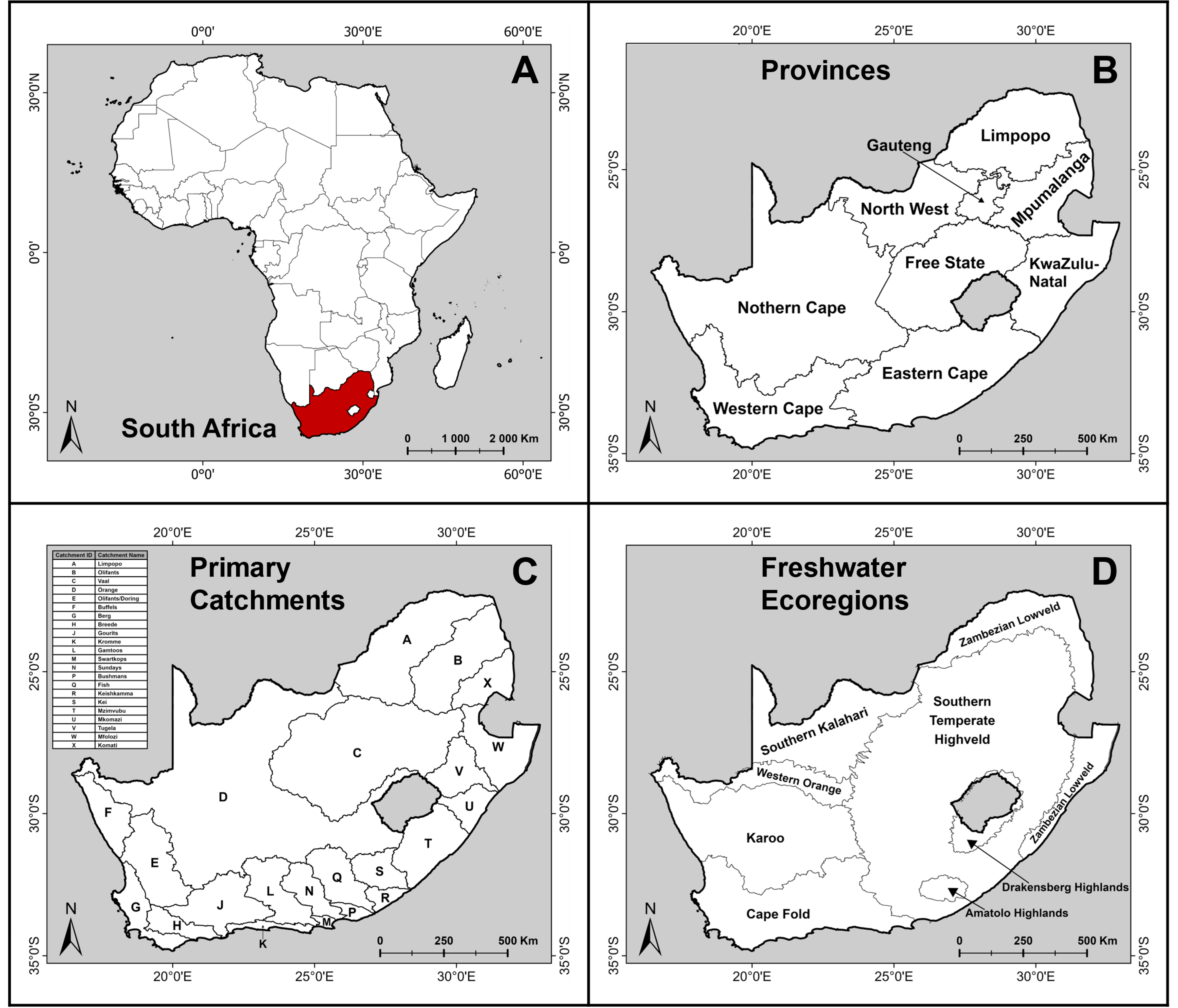
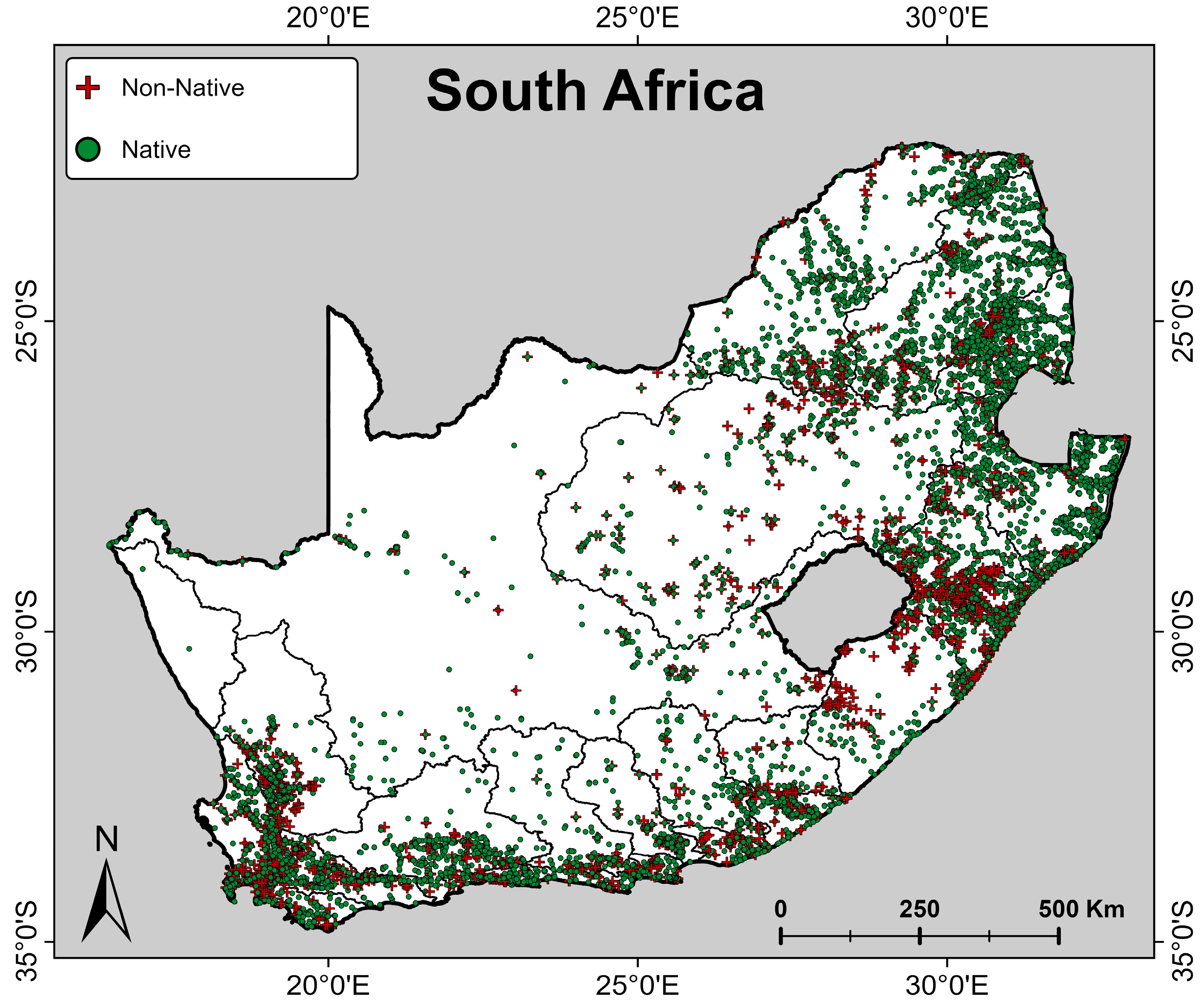
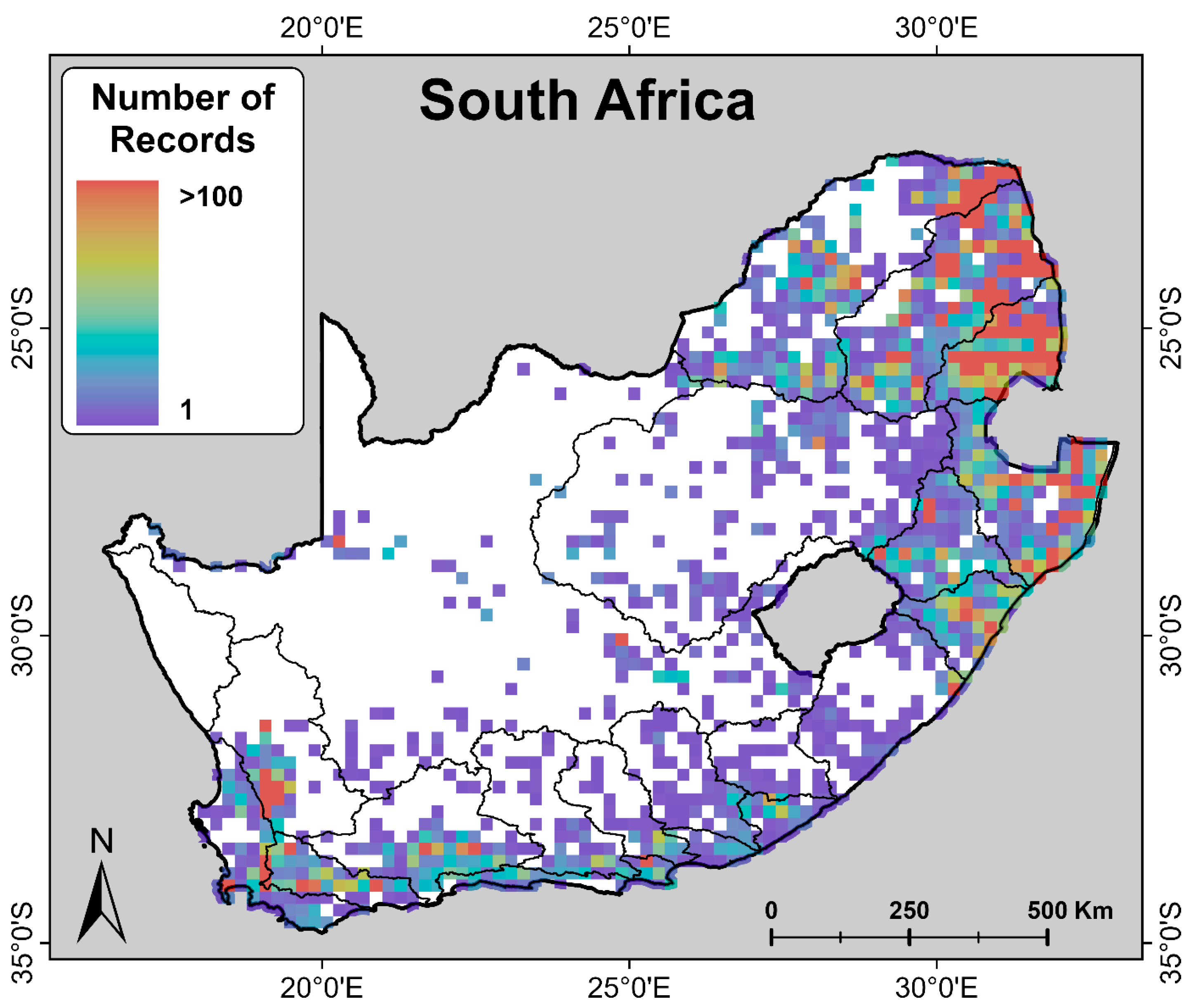
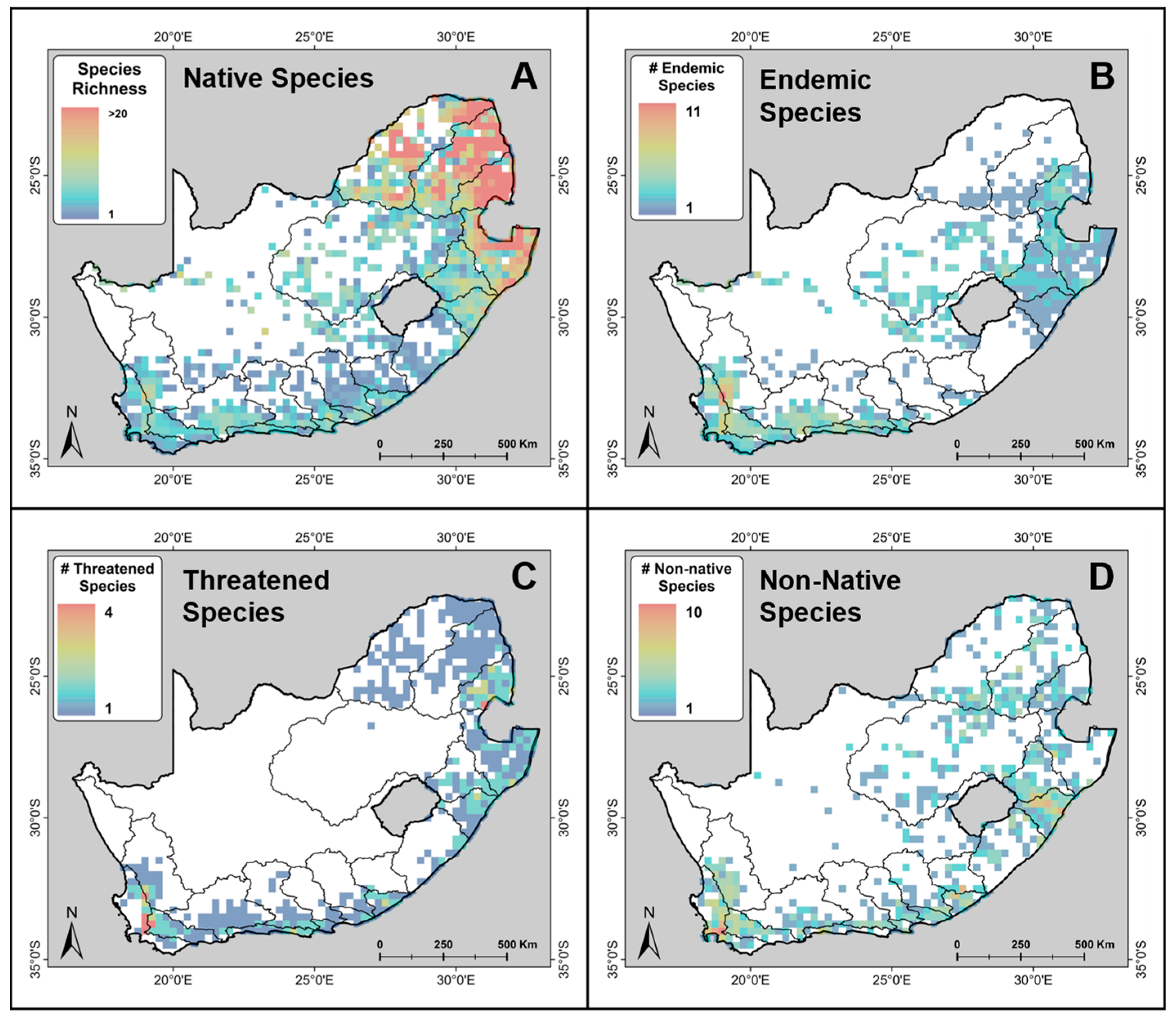
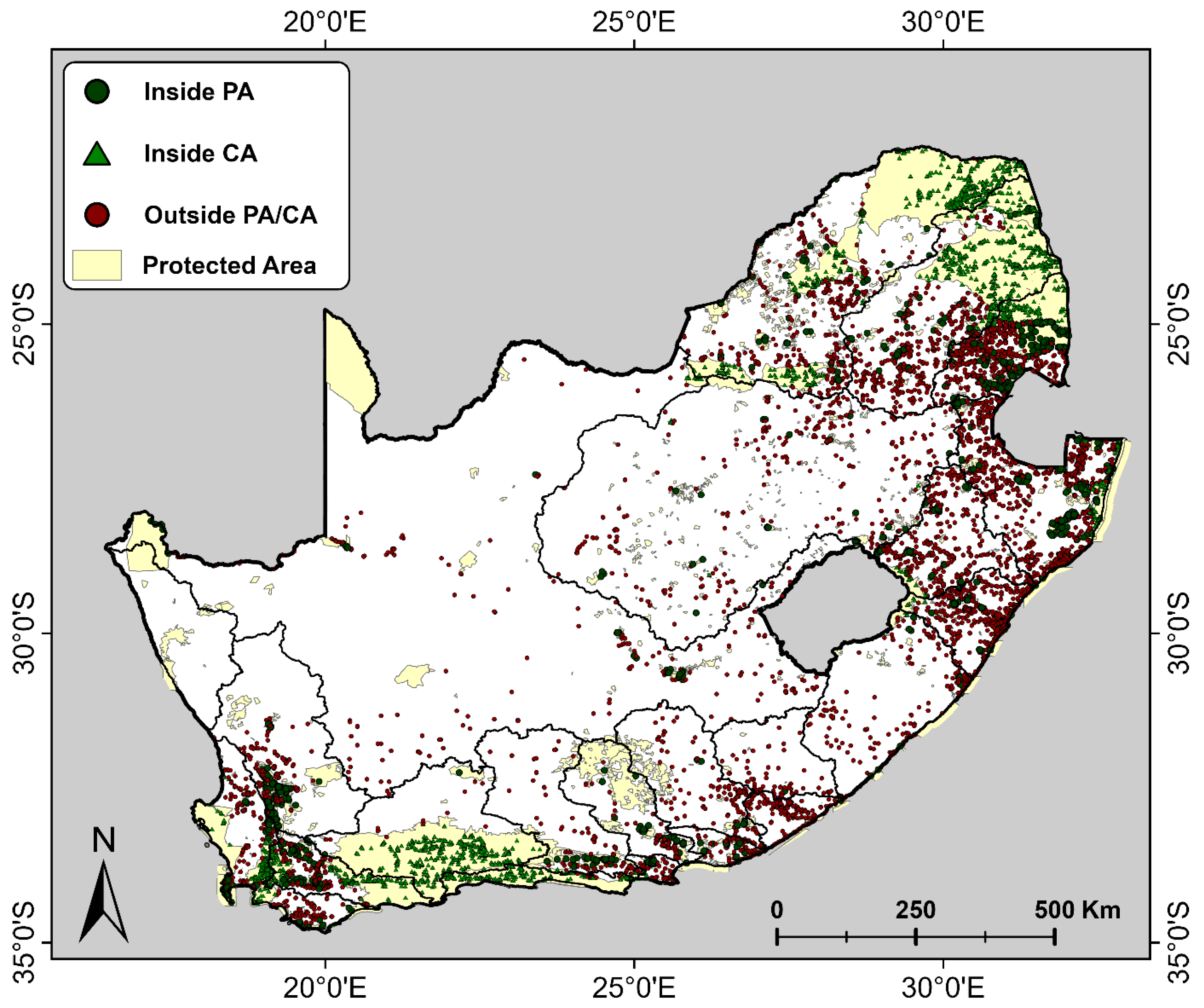
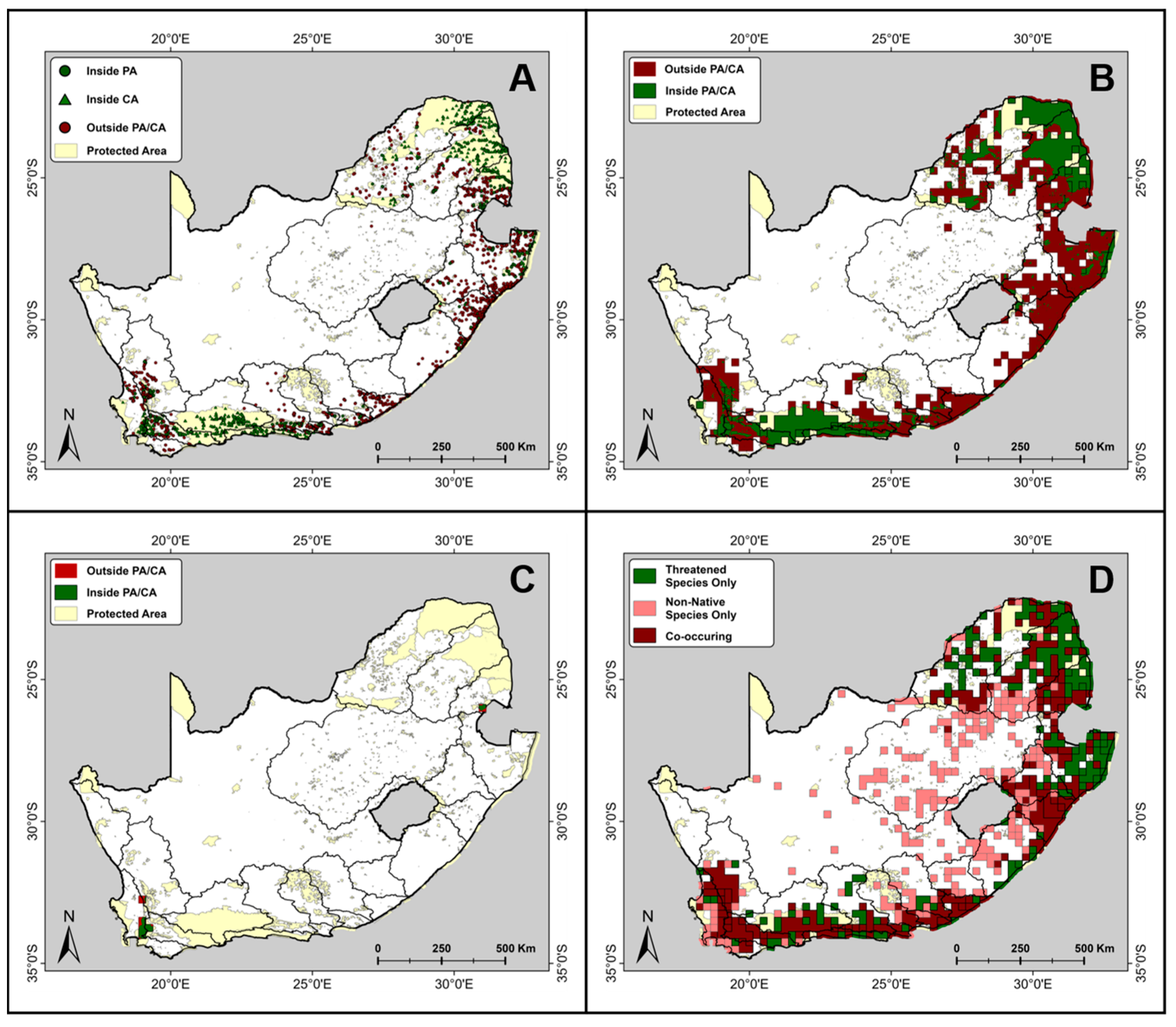
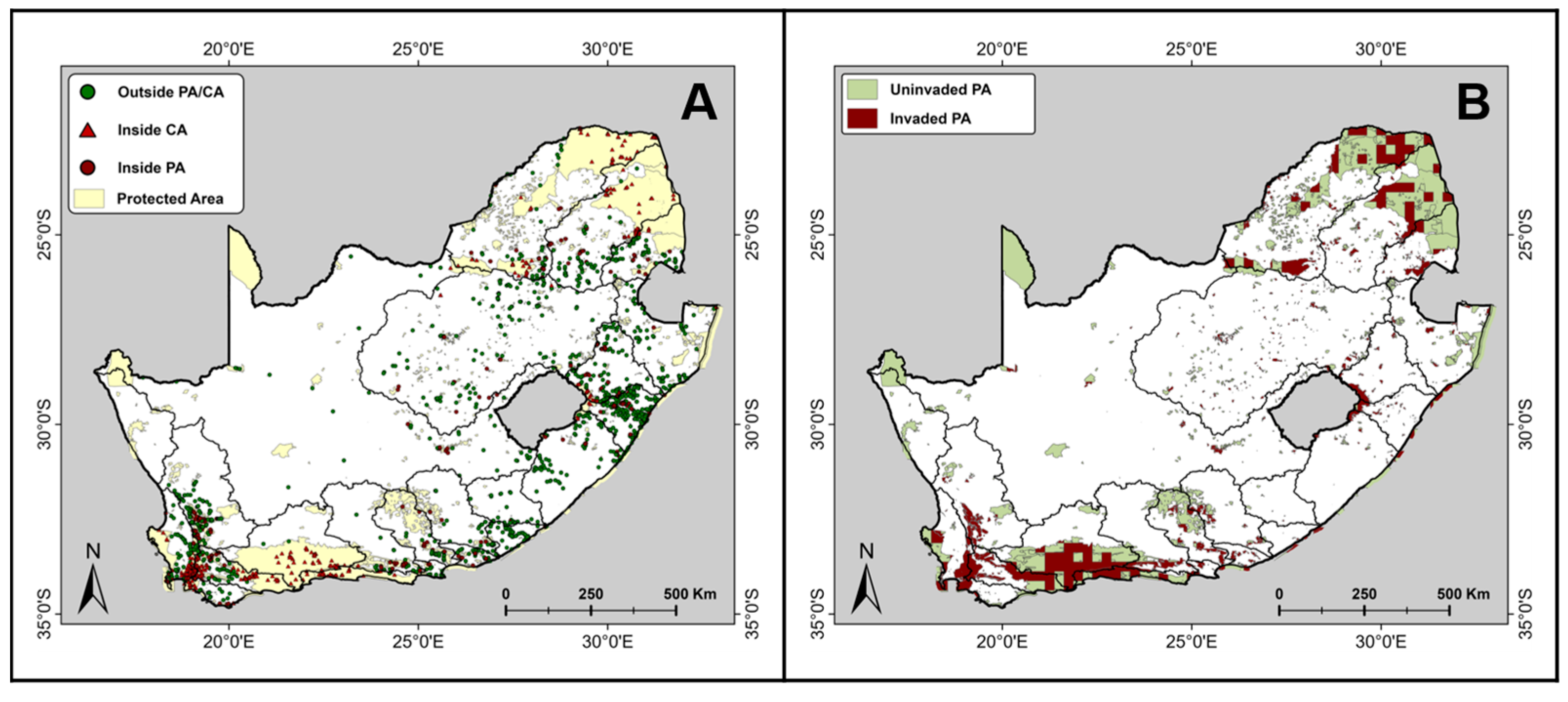
| Province | Records | Native Species | Extralimital Species * | Non-Native Species | Endemic Species + | Threatened Species |
|---|---|---|---|---|---|---|
| Eastern Cape | 2725 | 35 | 10 | 14 | 13 | 8 |
| Free State | 890 | 19 | 4 | 7 | 8 | 0 |
| Gauteng | 907 | 38 | 3 | 9 | 5 | 1 |
| KwaZulu-Natal | 11,411 | 74 | 8 | 20 | 13 | 8 |
| Limpopo | 14,353 | 61 | 6 | 11 | 7 | 2 |
| Mpumalanga | 11,411 | 65 | 7 | 12 | 7 | 6 |
| North West | 1058 | 37 | 5 | 7 | 6 | 1 |
| Northern Cape | 1285 | 39 | 9 | 9 | 13 | 1 |
| Western Cape | 8159 | 30 | 10 | 16 | 19 | 11 |
| Catchment ID | Catchment Name | Records | Native Species | Extralimital Species * | Non-Native Species | Endemic Species + | Threatened Species |
| Region A | Limpopo | 8355 | 60 | 7 | 9 | 7 | 1 |
| Region B | Olifants | 9823 | 59 | 7 | 10 | 6 | 4 |
| Region C | Vaal | 1240 | 34 | 6 | 10 | 7 | 1 |
| Region D | Orange | 1100 | 37 | 6 | 8 | 11 | 0 |
| Region E | Olifants/Doring | 3443 | 16 | 7 | 7 | 13 | 6 |
| Region F | Buffels | 6 | 0 | 3 | 0 | 0 | 0 |
| Region G | Berg | 1690 | 15 | 8 | 14 | 10 | 4 |
| Region H | Breede | 1902 | 13 | 5 | 10 | 10 | 3 |
| Region J | Gourits | 1269 | 12 | 7 | 7 | 7 | 2 |
| Region K | Kromme | 488 | 8 | 4 | 9 | 6 | 4 |
| Region L | Gamtoos | 433 | 10 | 4 | 6 | 6 | 2 |
| Region M | Swartkops | 309 | 10 | 3 | 6 | 4 | 1 |
| Region N | Sundays | 342 | 13 | 6 | 4 | 2 | 2 |
| Region P | Bushmans | 243 | 14 | 5 | 6 | 3 | 2 |
| Region Q | Fish | 293 | 11 | 5 | 7 | 2 | 2 |
| Region R | Keishkamma | 444 | 12 | 4 | 11 | 4 | 3 |
| Region S | Kei | 176 | 6 | 5 | 9 | 0 | 1 |
| Region T | Mzimvubu | 713 | 18 | 5 | 13 | 3 | 3 |
| Region U | Mkomazi | 2359 | 27 | 4 | 17 | 4 | 3 |
| Region V | Tugela | 2089 | 29 | 3 | 11 | 5 | 3 |
| Region W | Mfolozi | 7017 | 68 | 6 | 12 | 8 | 6 |
| Region X | Komati | 8471 | 58 | 3 | 12 | 4 | 5 |
Disclaimer/Publisher’s Note: The statements, opinions and data contained in all publications are solely those of the individual author(s) and contributor(s) and not of MDPI and/or the editor(s). MDPI and/or the editor(s) disclaim responsibility for any injury to people or property resulting from any ideas, methods, instructions or products referred to in the content. |
© 2023 by the authors. Licensee MDPI, Basel, Switzerland. This article is an open access article distributed under the terms and conditions of the Creative Commons Attribution (CC BY) license (https://creativecommons.org/licenses/by/4.0/).
Share and Cite
Kajee, M.; Dallas, H.F.; Griffiths, C.L.; Kleynhans, C.J.; Shelton, J.M. The Status of South Africa’s Freshwater Fish Fauna: A Spatial Analysis of Diversity, Threat, Invasion, and Protection. Fishes 2023, 8, 571. https://doi.org/10.3390/fishes8120571
Kajee M, Dallas HF, Griffiths CL, Kleynhans CJ, Shelton JM. The Status of South Africa’s Freshwater Fish Fauna: A Spatial Analysis of Diversity, Threat, Invasion, and Protection. Fishes. 2023; 8(12):571. https://doi.org/10.3390/fishes8120571
Chicago/Turabian StyleKajee, Mohammed, Helen F. Dallas, Charles L. Griffiths, Cornelius J. Kleynhans, and Jeremy M. Shelton. 2023. "The Status of South Africa’s Freshwater Fish Fauna: A Spatial Analysis of Diversity, Threat, Invasion, and Protection" Fishes 8, no. 12: 571. https://doi.org/10.3390/fishes8120571
APA StyleKajee, M., Dallas, H. F., Griffiths, C. L., Kleynhans, C. J., & Shelton, J. M. (2023). The Status of South Africa’s Freshwater Fish Fauna: A Spatial Analysis of Diversity, Threat, Invasion, and Protection. Fishes, 8(12), 571. https://doi.org/10.3390/fishes8120571





